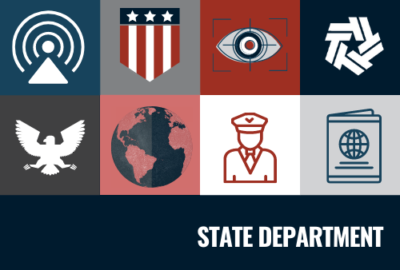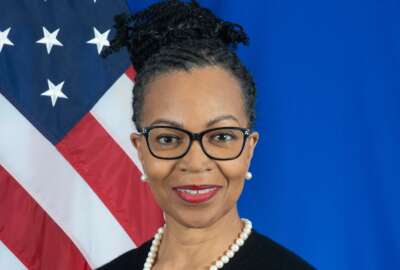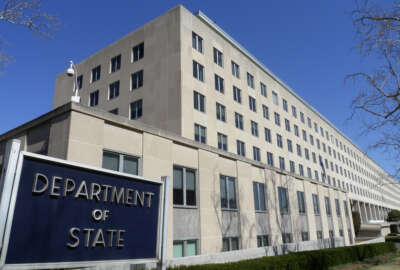Former State Department leaders urge Congress to address chronic Foreign Service workforce challenges
Former department leaders said the Foreign Service risks losing future generations of talent unless it modernizes its up-or-out culture and develops a more...
Best listening experience is on Chrome, Firefox or Safari. Subscribe to Federal Drive’s daily audio interviews on Apple Podcasts or PodcastOne.
The State Department, in order to address longstanding workforce and diversity challenges, is under pressure to reimagine the Foreign Service as something other than a 30-year career and to make its diplomatic corps more accommodating to borrow outside expertise when needed.
Former department leaders told the Senate Foreign Relations Committee’s subcommittee on State Department and USAID management that the Foreign Service risks losing future generations of talent unless it modernizes its up-or-out culture and develops a more inclusive workforce.
“The State Department has to offer a better value proposition for every employee 10 years in, or we’ll lose them to the private sector — to NGOs or nonprofits,” former Deputy Secretary of State Stephen Biegun told the subcommittee Wednesday.
The department is taking some steps to reform its workplace culture. Secretary of State Antony Blinken named former U.S. Ambassador to Malta Gina Abercrombie-Winstanley, a career employee with more than 30 years of experience, to serve as the department’s first chief diversity and inclusion officer.
Meanwhile, Blinken recently told lawmakers that the Biden administration’s fiscal 2022 budget request would support the department’s largest increase in personnel in more than a decade.
The Government Accountability Office has issued several reports documenting the department’s lack of progress in improving the diversity of its higher ranks. Meanwhile, Congress passed its last major department reorganization legislation more than 40 years ago.
Subcommittee Ranking Member Bill Hagerty (R-Tenn.), a former U.S. ambassador to Japan, urged Congress to update the 1980 Foreign Service Act and convene a bipartisan commission to “examine every aspect of American diplomacy.”
“We should be bold in reimagining the State Department, and this should be guided by some very basic foundational questions. To name just a few: What is the purpose of embassies in the 21st century? How can the State Department attract, retain and train the best talent, and what kind of infrastructure does the State Department need at home and abroad in the 21st century?” Hagerty said.
Marcie Ries, a former ambassador to Bulgaria and Albania, last year co-authored a report with Harvard University’s Belfer Center for Science and International Affairs, outlining ways to modernize the diplomatic workforce.
Ries said the department could address its “chronic failure” to improve the diversity of its ranks by allowing outside talent to enter the Foreign Service through mid-career opportunities.
Ries said standing up a Diplomatic Reserve Corps, a State Department equivalent to a military reserve force, would allow retired Foreign Service personnel and experts from outside the department to provide their skills on a part-time basis and allow the department to surge its capacity to respond to natural disasters and other emergencies.
Ries said a reserve corps of retired Foreign Service officers would lend their expertise to the department about once a month.
Ann-Marie Slaughter, the CEO of the New America think tank and the department’s former director of policy planning, said the department would be better served by mid-career experts signing up for a multi-year tour of service at any point in their career, rather than recruit talent for a 30-year career.
“I want us to be able to see a leading NGO leader or a top business person or university professor, who then says, ‘You know, I want to serve my country… I’ll do the training, but I’m not going to follow this traditional ladder,’ and then allow all those folks to be part of our reserve,” Slaughter said.
Biegun said a modernized State Department would be better positioned to respond to threats like COVID-19 and global pandemics.
“When it came time to respond to that pandemic, we had to build it on the fly. We were building the plane as we were flying it. Now the State Department and its incredible talent can overcome a lot of obstacles, but still, something like a retired diplomatic corps… would have been of enormous benefit to us,” he said.
Subcommittee Chairman Ben Cardin (D-Md.) said the department spends about half its training budget on language learning, but in at least one out of every four assignments, minimum language skills aren’t being met.
“In the Defense Department and defense budget, we have built-in redundancies so that we can surge and take care of contingencies that could occur that’s in our national security interests defend against. But at State, we really do not have that capacity to surge,” Cardin said.
Slaughter said the Foreign Service’s three-to-four-year rotation assignments don’t make much sense.
“Say you’re in Vietnam, you might be sent to Peru. You’re not likely to be sent to Japan, in part because of fears that you’ll go native — that you’ll spend too much time in one region. Other foreign services don’t do that. You know one Asian language, and then you learn another… There’s a lot of room there, I think, for recruiting differently,” Slaughter said.
Biegun said the State Department is recruiting more diverse classes of Foreign Service officers, but added that the department faces challenges with retaining mid-career talent, which disproportionately impacts employees of color.
Biegun said rethinking workforce training would help ensure a more diverse pool of mid-career talent stays on board.
“Training somebody to advance inside the organization is the best way to signal to them that there’s a future for them in the organization. When you don’t invest in training them, and if the leadership isn’t there to recruit them for promotional opportunities, it’s very easy for them to interpret that as a signal that they’re not wanted in the department,” Biegun said.
Biegun said about 15% of the department’s personnel should be in training at any given time. But instead, he said supervisors will press staff to start their assignment as soon as possible and forego training.
“The Pentagon would never do that. The United States military would never take somebody off a deployment and put them onto a new deployment – maybe in the most critical needs of the country – but as a routine matter, that would be unforgivable,” Biegun said.
Copyright © 2025 Federal News Network. All rights reserved. This website is not intended for users located within the European Economic Area.
Jory Heckman is a reporter at Federal News Network covering U.S. Postal Service, IRS, big data and technology issues.
Follow @jheckmanWFED






